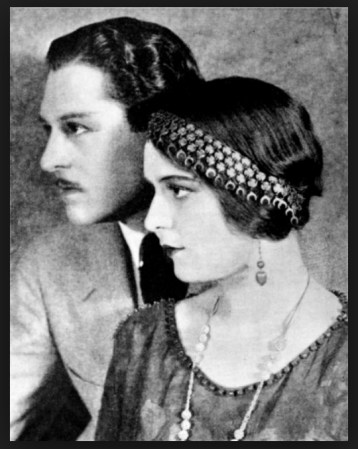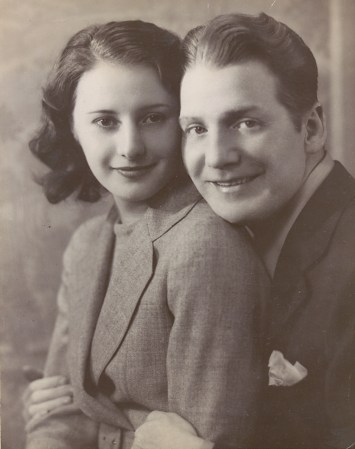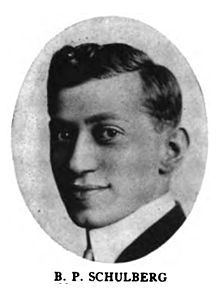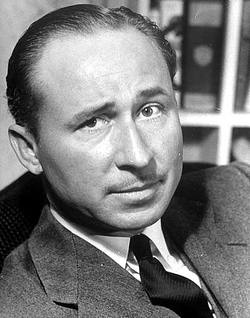What Hollywood figures inspired the characters in “A Star is Born”?
When I started out this post, I was ready with a relatively simple answer. In an April 2018 interview with William Wellman, Jr., at the Turner Classic Movies Classic Film Festival, he listed one couple. But the more I researched, the more complex this answer became.
Since the first studios were built in Hollywood, the lives and deaths of film stars were as dramatic as the roles they played on the screens. Their tragic lives and deaths inspired “What Price Hollywood?” (1932) – the unofficial precursor to “A Star is Born” —and the 1937 film “A Star Is Born” starring Janet Gaynor and Fredric March.”

John McCormick and Colleen Moore
Colleen Moore and John McCormick
Colleen Moore was one of the influences for “What Price Hollywood?” (1932), according to the book “The Bennetts: An Acting Family” by Brian Kellow. Moore was married to First National Pictures producer John McCormick. McCormick was responsible for Moore cutting her hair into a sleek bob for the flapper look. The actress and producer were married in 1923, collaborated on 20 films together and made millions of dollars. Business-wise, it was a successful match. But as Moore became even more famous, her husband’s alcoholism deepened and she covered up for him when he was hospitalized or at the studio. Moore divorced McCormick in 1930.

John Bowers and Marguerite De La Motte in a publicity photo for Daughters Who Pay (1925)
John Bowers and Marguerite De La Motte:
Silent film actor John Bowers started in films in 1914 and was in 95 films from 1914 to 1931. Marguerite De La Motte, who started in films in 1916, was a frequent co-star of Bowers’s. They first co-starred in the film “Desire” (1923) and were in a total of 12 films together from 1923 to 1927. John Bowers and Marguerite De La Motte were married in 1924. But when sound entered in films, Bowers’s film career ended. De La Motte was also in a few talking pictures, though she only appeared in five films from 1930 to 1942. Bowers began to have a drinking problem after his career ended, according to the website Silents are Golden, and the couple separated. Director Henry Hathaway remembered Bowers begging for a job, and Hathaway invited Bowers to dinner. When Bowers left, he said, “Well, this is the last time you’ll ever see me. You’ll have a real life picture. I’m going to jump overboard.”
On Nov. 13, 1936, John Bowers rented a boat, sailed it out into the Pacific Ocean and drowned. Police found his body floating near Las Flores, according to the book “A Life of Barbara Stanwyck: Steel-True 1907-1940” by Victoria Wilson. William Wellman, Jr., son of William Wellman who directed “A Star is Born” (1937), said Norman Maine was based on the marriage, career, and death of John Bowers, though Wellman was two weeks into shooting the film when Bowers died, according to Wilson’s book.

Barbara Stanwyck and Frank Faye
Frank Fay and Barbara Stanwyck:
Barbara Stanwyck biographer Victoria Wilson writes that the Vicki Lester and Norman Maine acting marriage was based on Frank Fay and Barbara Stanwyck during their marriage from 1928 to 1935.
When they were first married, Stanwyck was not acting in films, and Frank Fay was a famous vaudeville star and already acting in films. By 1935 when they divorced, Stanwyck’s star was rising, and Fay helped guide her success: from convincing Harry Cohn to hire her for “Mexicali Rose” to giving her screen test to director Frank Capra. Capra then made Stanwyck a star by casting her in four of his films, according to Wilson’s book. While Stanwyck’s films were successful, Fay’s failed, and he began to drink. Stanwyck tried to help him with his career and would appear with him on stage. They divorced due to his abuse and alcoholism. Barbara Stanwyck also did not attend the premiere of “A Star is Born” (1937).

John Barrymore
John Barrymore
Of any actor, John Barrymore has the most parallels to Norman Maine, the once famous matinee idol who fell into alcohlism as his career declined. John Barrymore was one of the top stars of stage and screen of the 1920s and 1930s, but drinking was his downfall. He became unreliable, and his roles became fewer and lacked prestige as the years wore on and he drank more. In his last film, “Playmates” (1941), co-starring comedic big band leader Kay Kyser, Barrymore’s character is a has-been who drinks too much. The fact that his life became a punchline in an RKO musical comedy is depressing. John Barrymore went to a sanitarium for a rest cure and director George Cukor visited him with a possible role, just like Oliver Niles does for Norman Maine. And like Maine, Barrymore turned down the role because it was too small, according to Wilson’s book. David O. Selznick even wanted John Barrymore for the role of Norman Maine in “A Star is Born” (1937), but at this point Barrymore had a hard time remembering his lines. John Barrymore died in 1942 at age 60 from pneumonia and cirrhosis of the liver.

Marshall Neilan
Marshall Neilan
Director Marshall Neilan is cited as an inspiration for Lowell Sherman’s director character of Max Carey in “What Price Hollywood?” (1932), who drinks too much and commits suicide at the end of the film, according to Kellow’s book. From 1913 to 1937, Neilan directed 107 films, but his work slowed after the dawn of sound due to his alcoholism. Neilan has a small role in the 1937 version of “A Star is Born” when Norman (Fredric March) goes to the race track after being released from the sanitarium. Neilan died in 1958 of throat cancer.

Tom Forman
Tom Forman
Another inspiration for Max Carey in “What Price Hollywood” (1932) is director Tom Forman. Author Adela Rogers St. Johns based her story “The Truth About Hollywood” on Forman. Forman directed successful films in Hollywood such as “Shadows” (1922) and “The Virginian” (1923). However, his career took a turn and Forman was left with low-budget directing projects. On Nov. 7, 1926, Forman shot himself through the heart and died at the age of 33. In the film “What Price Hollywood,” Max Carey dies in the same manner.

John Gilbert and Virginia Bruce
William Wellman’s son, William Wellman, Jr., wrote in the book “Wild Bill Wellman: Hollywood Rebel,” that John Gilbert and the decline of his career was another inspiration for his father’s Norman Maine in “A Star is Born” (1937). John Gilbert was one of the top stars of the silent era, and his alcoholism was part of his downfall — similar to John Barrymore. However, his daughter Leatrice Gilbert Fountain says “A Star is Born” is not based on her father in her 1985 book, “Dark Star: The Untold Story of the Meteoric Rise and Fall of Legendary Silent Screen Star John Gilbert.” But Gilbert being an inspiration for Norman Maine would make sense, particularly, because he was married to up-and-coming starlet Virginia Bruce from 1932 to 1934. Bruce was gaining popularity while Gilbert was practically a has-been. Gilbert’s last film was in 1934, and he died in 1936 at age 38 of a heart attack.

B.P. Schulberg
B.P. Schulberg
B. P. Schulberg, film pioneer and studio executive, was the inspiration for studio head, Oliver Niles, according to the book “A Life of Barbara Stanwyck” by Victoria Wilson. Niles is played by Adolphe Menjou in the 1937 version and Charles Bickford in the 1954 version

Russell Birdwell
Russell Birdwell
Russell Birdwell was the model of ruthless publicity agent Matt Libby, according to Victoria Wilson’s book. Libby is played by Lionel Stander in the 1937 version and Jack Carson in the 1954 version. One of Birdwell’s publicity stunts included hiring an actress in 1927 to dress in all black and lay flowers on the tomb of Rudolph Valentino on the first anniversary of his death, known as “The Woman in Black.”
Other nods to real life:
- Vicki Lester’s closing line of “I am Mrs. Norman Maine” was inspired by Dorothy Davenport who was billed as Mrs. Wallace Reid after her husband, actor Wallace Reid, died in 1923. Reid died due to complications from his addiction to morphine. This is the last line in both the 1937 and 1954 version.
- The funeral scenes in the 1937 and 1954 versions are said to be inspired by Irving Thalberg’s funeral and the response the crowd had to his widow, Norma Shearer. A Sept. 16, 1936, newspaper said 1,500 attended Thalberg’s funeral.
Check out the Comet Over Hollywood Facebook page, follow on Twitter at @HollywoodComet or e-mail at cometoverhollywood@gmail.com
